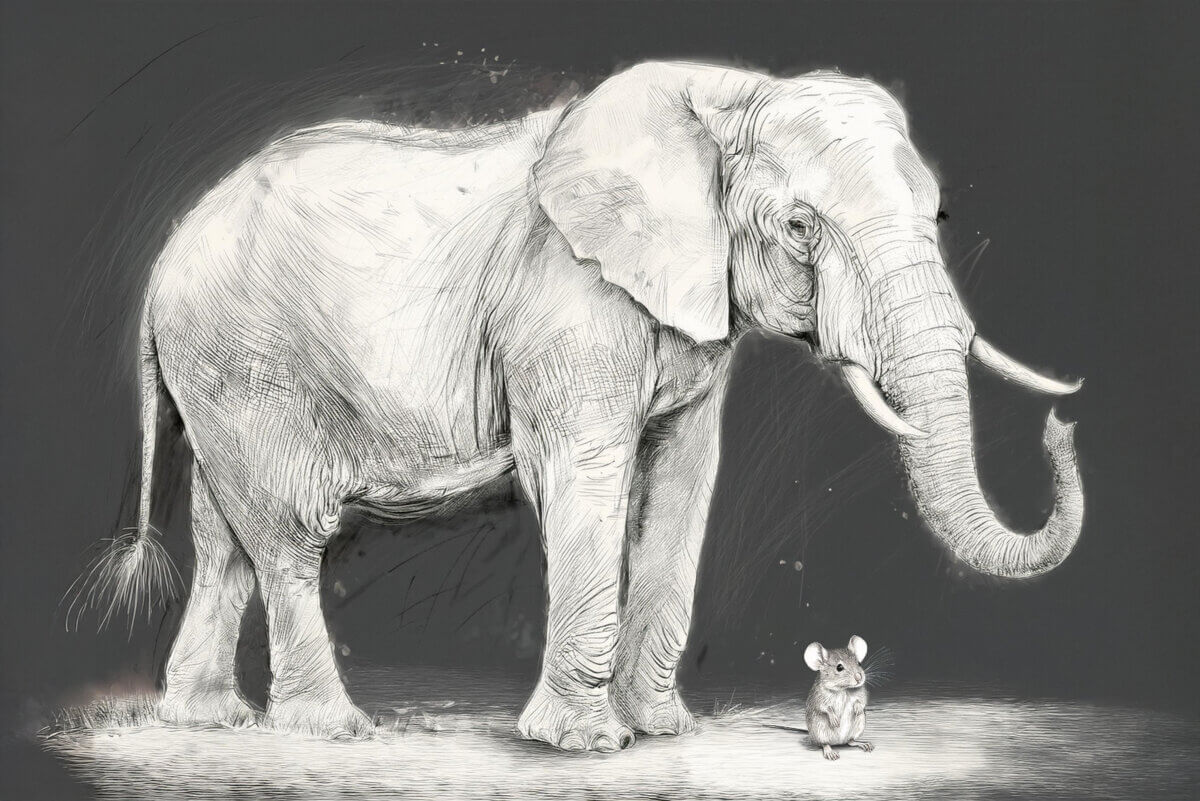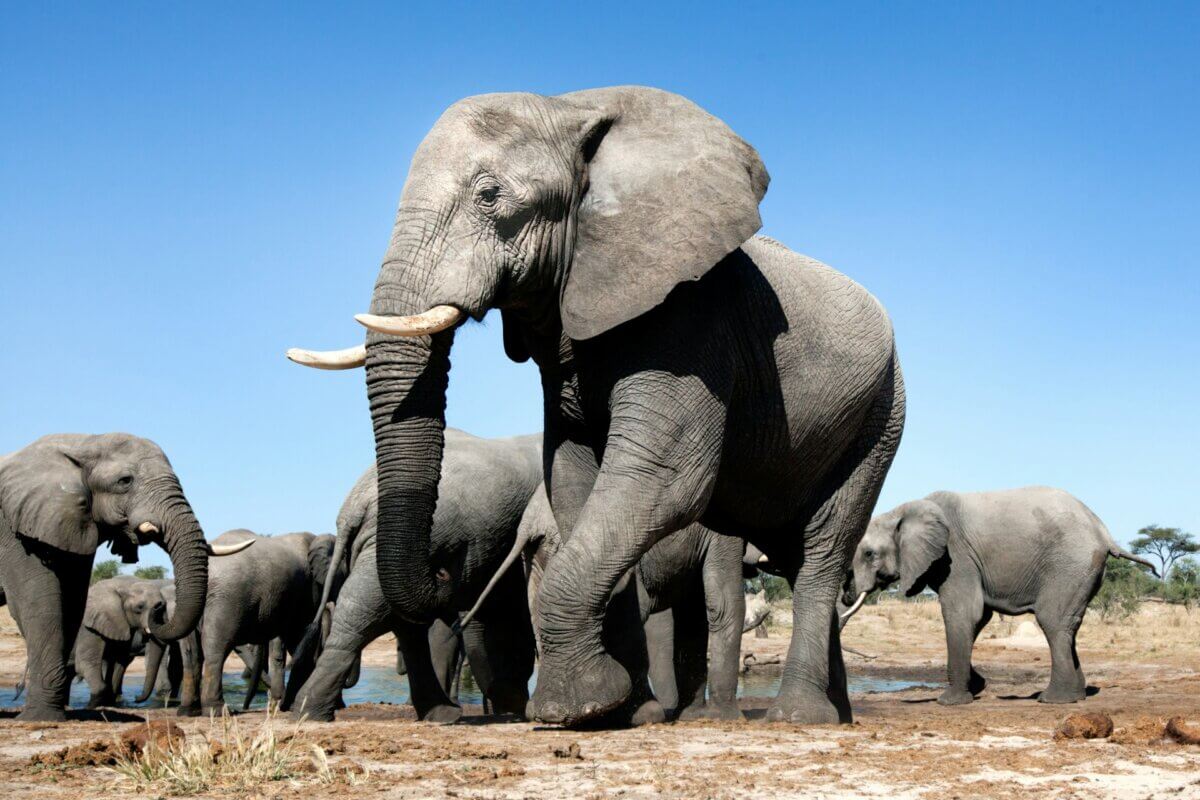
(© Nagge - stock.adobe.com)
Despite the finding, scientists say bigger species also develop stronger defenses against the disease
In a nutshell
- Larger animals do get more cancer than smaller ones, overturning the 45-year-old “Peto’s paradox” which suggested no link between animal size and cancer risk
- Species that evolved larger body sizes more rapidly, like elephants, also developed better cancer defenses. An elephant has about the same cancer risk as a tiger, despite being 10 times larger
- Studying animals with exceptional cancer resistance (like naked mole rats) or unusual susceptibility (like budgerigars) could lead to breakthrough treatments for human cancer
LONDON — For decades, scientists believed something strange was happening in the animal kingdom: despite having many more cells that could potentially turn cancerous, elephants didn’t seem to get more cancer than mice. As it turns out, this puzzling observation, called “Peto’s paradox,” has been overturned by surprising new research.
Researchers from the University College London, the University of Reading and Johns Hopkins School of Medicine in Baltimore discovered that larger animals do, in fact, develop cancer more frequently than smaller ones. This finding follows the basic logic we might expect: more cells mean more opportunities for cancer-causing mutations.
“Everyone knows the myth that elephants are afraid of mice, but when it comes to cancer risk, mice are the ones who have less to fear,” said Professor Chris Venditti, senior author of the research at the University of Reading, in a statement. “We’ve shown that larger species like elephants do face higher cancer rates – exactly what you’d expect given they have so many more cells that could go wrong.”
The study analyzed cancer data across amphibians, birds, mammals, and reptiles, revealing a predictable pattern: as body size increases, so does cancer prevalence. However, species that evolved larger body sizes more rapidly also developed enhanced cancer-fighting mechanisms that helped mitigate their cancer risk.

“These results represent empirical evidence showing that larger body size is related to higher cancer prevalence, thus rejecting Peto’s paradox and demonstrating the importance of heterogeneous routes of body size evolution in shaping anticancer defenses,” the researchers write in their paper.
Why size matters in animal cancer
Cancer occurs when cells accumulate mutations during division, a normal process needed for growth and repair. With more cells and more divisions, there should logically be more chances for cancer-causing mutations. This relationship is already known within species—taller humans and larger dogs have higher cancer rates than their smaller counterparts—but until now, the pattern was thought to break down when comparing different species.
The research team examined autopsy data from 263 species: 31 amphibians, 79 birds, 90 mammals, and 63 reptiles. This dataset was much larger than those used in previous studies, allowing for better statistical analysis. Rather than calculating the percentage of cancer cases relative to the number of autopsies performed, the researchers directly counted the observed number of cancer cases, reducing statistical errors and improving accuracy.
The study found that larger animals consistently showed higher cancer rates than smaller ones. Despite adaptations that evolved to counteract cancer risks, an elephant still experiences more cancer than a mouse, following the biological prediction that more cells equal more cancer risk. However, species that underwent rapid increases in body size evolved specialized cellular controls that partially counterbalanced this effect.

“When species needed to grow larger, they also evolved remarkable defenses against cancer. Elephants shouldn’t fear their size – they developed sophisticated biological tools to keep cancer in check. It’s a beautiful example of how evolution finds solutions to complex challenges,” explained Dr. Joanna Baker, co-author from the University of Reading.
Which animals buck the trend?
The study highlights the Asian elephant, which has about the same cancer risk as a tiger—an animal only one-tenth its size. This suggests that as elephants evolved to become larger, they developed stronger molecular safeguards against cancer, including multiple copies of the tumor suppressor gene TP53. These adaptations do not eliminate the connection between size and cancer, but they substantially reduce it.
The research also identified species that significantly deviated from expected cancer rates. The common budgerigar exhibited cancer rates 40 times higher than expected for its size, while the naked mole rat showed extraordinary resistance to cancer.
“Finding which animals are naturally better at fighting off cancer opens exciting new paths for research. By studying these successful species, we can better understand how cancers develop and potentially discover new ways to fight the disease. This could lead to breakthrough treatments in the future,” explained Dr. George Butler, lead author of the research at University College London and Johns Hopkins.

Implications for Human Cancer Research
These findings reshape our understanding of how body size relates to cancer across species. Rather than a paradox, the relationship between body size and cancer follows expected biological principles, while evolutionary innovations modify these risks.
For decades, scientists pointed to elephants as the prime example of Peto’s paradox—large animals that seemingly escaped the cancer burden their size should bring. This research shows that elephants aren’t immune to the biological rules governing cancer risk; they’ve just evolved highly effective countermeasures that make them appear less cancer-prone than their size would predict.
Modern medicine makes it difficult to determine how humans fit into this pattern. While the research confirms that larger species generally have higher cancer rates, it also suggests that some have evolved advanced cellular defenses. This opens the door to new insights into cancer evolution and potential breakthroughs in human medicine.
Ultimately, the study demonstrates how evolution works not by breaking biological rules but by developing innovative solutions within them. Larger animals couldn’t escape the reality that more cells create more cancer opportunities, but they evolved molecular adaptations to reduce the impact of this relationship.
In the end, Peto’s paradox wasn’t a paradox at all – just an incomplete picture of the evolutionary relationship between body size, cellular controls, and cancer risk. The resolution of this long-standing biological mystery shows that nature’s patterns often become clearer when we examine them with better data and analytical methods.
Paper Summary
Methodology
The researchers analyzed cancer data from veterinary autopsies across 263 species spanning four major vertebrate groups. They employed advanced statistical methods that accounted for evolutionary relationships between species, using a Bayesian phylogenetic framework. Unlike previous studies, they directly modeled the observed number of cancer cases rather than calculating proportions, which allowed for more accurate statistical analysis and reduced potential sources of error.
To examine how evolutionary history influenced cancer defenses, the researchers calculated “pathwise rates” – a measure of how rapidly body size evolved in different lineages. They analyzed evolutionary trees where branch lengths represented rates of body size evolution, then summed the total evolutionary change each species had undergone from its ancestors to the present day, providing insights into how evolutionary history shaped cancer risk.
Results
The study found a significant positive relationship between body size and cancer across all vertebrate groups studied. Larger animals consistently showed higher rates of both benign and malignant tumors, with this pattern holding true regardless of whether the animals were warm-blooded (birds and mammals) or cold-blooded (amphibians and reptiles).
Importantly, species that evolved larger body sizes more rapidly showed lower cancer rates than would be expected based solely on their size. For example, elephants had about 56% less cancer than predicted by size alone, while a much smaller fruit bat only showed a 12% reduction. The study also identified outlier species with exceptional cancer profiles – budgerigars showed cancer rates 40 times higher than expected for their size, while naked mole rats demonstrated remarkable cancer resistance despite their relatively long lifespans.
Limitations
The study faced several limitations, including incomplete data on species longevity and age at death, which could affect interpretations since longer-lived animals might accumulate more cancer over time. The research primarily focused on animals in captivity, where environmental factors differ from the wild, potentially influencing cancer rates. Additionally, sample sizes varied between species, and the study couldn’t directly measure the molecular mechanisms underlying cancer resistance in different species.
These limitations suggest that while the overall pattern of size-related cancer risk is robust, the specific mechanisms and extent of cancer defense adaptations may warrant further investigation with more complete data on lifespan, environmental factors, and molecular mechanisms.
Discussion and Takeaways
This research fundamentally changes our understanding of cancer evolution by showing that larger animals do experience higher cancer rates, but species that evolved larger sizes rapidly also developed enhanced defenses against cancer. These findings not only resolve Peto’s paradox but highlight how evolution has shaped diverse anticancer mechanisms across different animal lineages. The study suggests that investigating species with exceptional cancer resistance, like the naked mole rat, could reveal new approaches to human cancer prevention.
The discovery of differential cancer defenses between warm-blooded and cold-blooded animals opens new avenues for understanding how metabolic demands influence cellular control mechanisms. By revealing these evolutionary patterns, the research provides a broader perspective on the relationship between body size, cellular growth regulation, and cancer risk, potentially informing novel therapeutic strategies for human medicine.
Funding and Disclosures
The research was supported by the US Department of Defense, the Prostate Cancer Foundation, the Patrick C. Walsh Prostate Cancer Research Fund, several National Cancer Institute grants, and a Leverhulme Trust Research Leadership Award. Several authors disclosed financial interests in biotechnology companies: K.J. Pienta is a consultant for CUE Biopharma, Inc. and holds equity interest in CUE Biopharma, Inc., Keystone Biopharma, Inc., PEEL Therapeutics, Inc, and Kreftect, Inc. S.R. Amend holds equity interest in Keystone Biopharma, Inc.
Publication Information
The paper, titled “No evidence for Peto’s paradox in terrestrial vertebrates,” was published in the Proceedings of the National Academy of Sciences (PNAS) on February 24, 2025 (Volume 122, Number 9, e2422861122). The research was led by George Butler from University College London Cancer Institute and Chris Venditti from the School of Biological Sciences at the University of Reading, with collaborators from Johns Hopkins School of Medicine.







